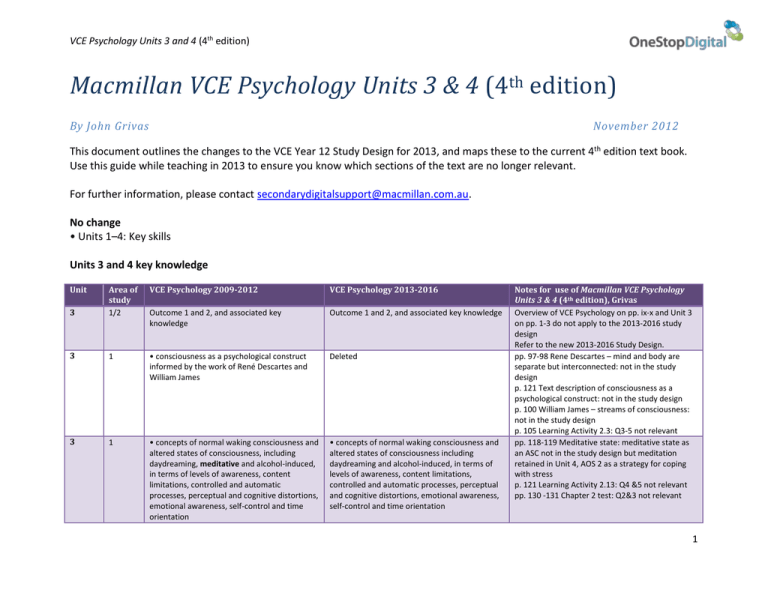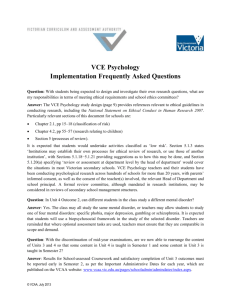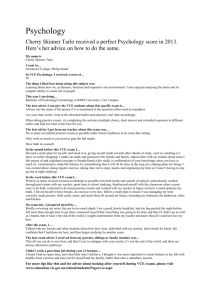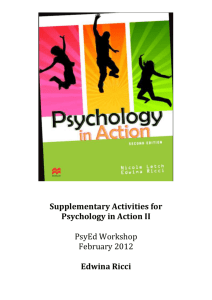Units 3 and 4 key knowledge
advertisement

VCE Psychology Units 3 and 4 (4th edition) Macmillan VCE Psychology Units 3 & 4 (4th edition) By John Grivas November 2012 This document outlines the changes to the VCE Year 12 Study Design for 2013, and maps these to the current 4th edition text book. Use this guide while teaching in 2013 to ensure you know which sections of the text are no longer relevant. For further information, please contact secondarydigitalsupport@macmillan.com.au. No change • Units 1–4: Key skills Units 3 and 4 key knowledge Unit VCE Psychology 2009-2012 VCE Psychology 2013-2016 3 Area of study 1/2 Outcome 1 and 2, and associated key knowledge Outcome 1 and 2, and associated key knowledge 3 1 • consciousness as a psychological construct informed by the work of René Descartes and William James Deleted 3 1 • concepts of normal waking consciousness and altered states of consciousness, including daydreaming, meditative and alcohol-induced, in terms of levels of awareness, content limitations, controlled and automatic processes, perceptual and cognitive distortions, emotional awareness, self-control and time orientation • concepts of normal waking consciousness and altered states of consciousness including daydreaming and alcohol-induced, in terms of levels of awareness, content limitations, controlled and automatic processes, perceptual and cognitive distortions, emotional awareness, self-control and time orientation Notes for use of Macmillan VCE Psychology Units 3 & 4 (4th edition), Grivas Overview of VCE Psychology on pp. ix-x and Unit 3 on pp. 1-3 do not apply to the 2013-2016 study design Refer to the new 2013-2016 Study Design. pp. 97-98 Rene Descartes – mind and body are separate but interconnected: not in the study design p. 121 Text description of consciousness as a psychological construct: not in the study design p. 100 William James – streams of consciousness: not in the study design p. 105 Learning Activity 2.3: Q3-5 not relevant pp. 118-119 Meditative state: meditative state as an ASC not in the study design but meditation retained in Unit 4, AOS 2 as a strategy for coping with stress p. 121 Learning Activity 2.13: Q4 &5 not relevant pp. 130 -131 Chapter 2 test: Q2&3 not relevant 1 VCE Psychology Units 3 and 4 (4th edition) 3 1 3 1 3 1 3 1 3 1 3 1 sleep as an altered state of consciousness: purpose, characteristics and patterns of the stages of sleep including rapid eye movement (REM) and the non-rapid eye movement (NREM) stages of sleep -- measurement of physiological responses including electroencephalograph (EEG), electrooculargraph (EOG), heart rate, body temperature and galvanic skin response (GSR) – the role of the reticular activating system in selective attention and wakefulness; role of the thalamus in directing attention and switching sensory input on and off –– perceptual anomalies including motion after-effect, change blindness, synaesthesia • the application and use of brain research methods in investigating the relationship between biological and cognitive factors of human behaviours including: –– direct brain stimulation and transcranial magnetic stimulation (TMS) –– brain recording and imaging techniques: computed tomography (CT), positron emission tomography (PET), single photon emission computed tomography (SPECT), magnetic resonance imaging (MRI), and functional magnetic resonance imaging (fMRI) • research methods and ethical principles associated with the study of the brain and sleep as an altered state of consciousness: purpose of sleep, characteristics and patterns of the stages of sleep including rapid eye movement (REM) and the nonrapid eye movement (NREM) stages of sleep –– measurement of physiological responses including electroencephalograph (EEG), electromyography (EMG), electro-oculargraph (EOG), heart rate, body temperature and galvanic skin response (GSR) Deleted Deleted Deleted • research methodologies and ethical principles associated with the study of the brain and states Change of wording in study design, does not affect text. electromyography (EMG) is new content but is covered on p.134 pp. 203-204 The reticular activating system: not in the study design pp. 204-206 The thalamus: not in the study design p. 206 Learning Activity 4.12 not relevant pp. 225-226 Perceptual anomalies: not in the study design pp. 226-228 Motion after-effect: not in the study design p. 228 Learning Activity 4.18 not relevant pp. 226-232 Change blindness: not in the study design p. 232 Learning Activity 4.19 not relevant p. 233 Learning Activity 4.20 not relevant pp. 233-236 Synesthesia: not in the study design p. 232 Learning Activity 4.21 not relevant p. 233 Learning Activity 4.22 not relevant p. 233 Learning Activity 4.23 not relevant pp. 237-259 Brain research methods: not in the study design All Learning Activities on brain research methods not relevant p. 264 Chapter 4 true/false quiz: Q3, Q9, Q10 not relevant pp. 265-69 Chapter 4 test: MC Q2, Q6, Q15, Q16, Q18, Q21, Q22, Q24, Q25 & SA Q3-5 not relevant Change of wording in study design, does not affect text. 2 VCE Psychology Units 3 and 4 (4th edition) states of consciousness, as outlined in the introduction to the unit –– role of the neuron in memory formation informed by the work of E Richard Kandel of consciousness, as outlined in the introduction to Unit 3 on page 22 work of E Richard Kandel –– the neuron in memory formation including the role of axons, dendrites, synapses and neurotransmitters 3 2 3 2 –– roles of the hippocampus and temporal lobe –– role of the temporal lobe including the hippocampus and the amygdala 3 2 • models for explaining human memory 3 2 • comparison of models for explaining human memory: –– organisation of long-term memory including declarative and episodic memory, and semantic network theory 3 2 • strengths and limitations of psychological theories of forgetting • manipulation and improvement of memory: –– forgetting curve as informed by the work of Hermann Ebbinghaus 3 2 mnemonic devices including acronyms, acrostics, peg-word method, narrative chaining and method of loci 3 2 research methods and ethical principles associated with the study of memory, as outlined in the introduction to the unit –– organisation of long-term memory including declarative (episodic and semantic) and procedural memory, and semantic network theory • strengths and limitations of theories of forgetting –– forgetting curve as informed by the work of Hermann Ebbinghaus Note: the ‘dash point’ has been shifted to align with a different ‘dot point’ Deleted: peg-word method, and method of loci research methodologies and ethical principles associated with the study of memory, as outlined in the introduction to Unit 3 on page 22 pp.334-336 Role of neuron in memory – still relevant except for specific references to Kandel’s studies p. 337 Learning Activity 6.26: Q1-7, Q11 not relevant p. 337 Learning Activity 6.27: relevant but do not explicitly refer to Kandel’s research Role of the amygdala is new content. Macmillan will supply new content to support this at the start of 2013. This will be available through the VCE Psychology product at www.OneStopDigital.com.au The specified models are compared throughout chapter 6. All specified LTM systems and sub-systems are covered. Strengths and limitations of all specified psychological theories of forgetting are covered (as is the physiological decay theory which is retained in the new study design). pp. 404-405 Peg-word method: not in the study design pp. 406-408 Method of loci: not in the study design p. 414 Chapter 8 true/false quiz: Q10 not relevant pp. 415-418 Chapter 8 test: MC Q1-3, Q7 & Q10 refer to deleted mnemonic devices Change of wording in study design, does not affect text. 3 VCE Psychology Units 3 and 4 (4th edition) Unit Area of study VCE Psychology 2009-2012 VCE Psychology 2013-2016 4 1/2 Outcome 1 and 2, and associated key knowledge Outcome 1 and 2, and associated key knowledge 4 1 • neural basis of learning: –– the development of neural pathways including the role of axons, dendrites, synapses and neurotransmitters –– developmental plasticity and adaptive plasticity of the brain: changes to the brain in response to learning and experience; timing of experiences 4 1 • mechanisms of learning: –– areas of the brain and neural pathways involved in learning, synapse formation, role of neurotransmitters –– developmental plasticity and adaptive plasticity of the brain: changes to the brain in response to learning and experience; timing of experiences –– use of imaging technologies in identification of localised changes in the brain due to learning specific tasks • applications of, and comparisons of, learning theories: –– one-trial learning with reference to taste aversion as informed by John Garcia and Robert A Koelling (1966) –– trial-and-error learning as informed by Edward Lee Thorndike’s puzzle-box experiment –– observational learning (modelling) processes in terms of the role of attention, retention, reproduction, motivation, reinforcement as informed by Albert Bandura’s (1961, 1963a, 1963b) experiments with children –– insight learning as informed by Wolfgang Kőhler –– latent learning as informed by Edward Tolman • applications, and comparisons, of learning theories: –– trial-and-error learning –– observational learning (modelling) processes in terms of the role of attention, retention, reproduction, motivation, reinforcement as informed by Albert Bandura’s social learning theory Deleted: one-trial learning; specific reference to Edward Lee Thorndike’s puzzle-box experiment; insight learning; latent learning Notes for use of Macmillan VCE Psychology, Units 3& 4, 4th Edition, Grivas Overview of VCE Psychology on pp. ix-x and Unit 4 on pp. 419-421 do not apply to the 2013-2016 study design Refer to the new 2013-2016 Study Design. Neural basis of learning is covered by Chapter 9 Mechanisms of learning. pp. 429-341 Box 9.2 Between neuron transmission: neurotransmitters, should be viewed as core text References to imaging technologies throughout Chapter 9 text, particularly in Box 9.3 and Box 9.5 (and Box 10.10 on p.522), are not of direct relevance. pp. 477-478 Thorndike’s experiments with cats is not of specific relevance p. 478 Learning Activity 10.11: Q5 &6 not relevant pp. 506-508 One-trial learning and taste aversion: not in the study design p. 509 Learning Activities 10.27 & 10.28 not relevant pp. 511-517 Bandura’s experiments with children: 1961, 1963a, 1963b experiments with children are not of specific relevance to the exam p. 518 Learning Activities 10.31-10.33 not relevant pp. 523-526 Insight learning: not in the study design p. 525 Learning Activity 10.36 not relevant p. 526 Learning Activity 10.37 not relevant pp. 527-529 Latent learning: not in the study design p. 530 Learning Activity 10.38 not relevant pp. 530-531 Learning Activities 10.39-41 not entirely relevant nor suitable for a SAC p. 531 Chapter 10 true/false quiz: Q3, Q6, Q7, Q10 not relevant pp. 532-540 Chapter 10 test: MC Q9, Q13, Q21, Q22, Q28 & SA Q4 & Q7 are not relevant 4 VCE Psychology Units 3 and 4 (4th edition) 4 1 4 2 4 2 –– physiological and psychological characteristics of responses to stress including fight-flight response, eustress and distress; strengths and limitations of Selyes’ General Adaptation Syndrome 4 2 • application of a biopsychosocial framework to understanding and managing simple phobia as an example of an anxiety disorder 4 2 • research methods and ethical principles associated with the study of mental health, as outlined in the introduction to the unit • research methods and ethical principles associated with the study of learning, as outlined in the introduction to the unit On completion of this unit the student should be able to differentiate between mental health and mental illness, and use a biopsychosocial framework to explain the causes and management of stress, simple phobia and a selected mental disorder. • research methodologies and ethical principles associated with the study of learning, as outlined in the introduction to Unit 3 on page 22 On completion of this unit the student should be able to differentiate between mental health and mental illness, and use a biopsychosocial framework to explain the causes and management of stress and a selected mental disorder. Note: specific phobia becomes one of four options for the study of a mental disorder. –– physiological and psychological characteristics of responses to stress including fight-flight response, eustress and distress Deleted: strengths and limitations of Selyes’ General Adaptation Syndrome • application of a biopsychosocial framework to understanding ONE of the following four types of mental disorder and its management: Anxiety disorder: specific phobia Note: specific phobia becomes one of four options for the study of a mental disorder. • research methodologies and ethical principles associated with the study of mental health, as outlined in the introduction to Unit 3 on page 22 All prescribed content is covered. All prescribed and optional content is covered. The text uses the term ‘specific phobia’. pp. 588-592 Selye’s general adaptation syndrome: not in the study design p. 594 Learning Activity 12.4 & 12.5 not relevant p. 625 Chapter 12 true/false quiz: Q6 not relevant pp. 626-629 Chapter 12 test: MC Q3, Q11, Q12 & SA Q4 are not relevant All prescribed and optional content is covered. The text uses the term ‘specific phobia’. Note that specific details relating to specific phobia, major depression and schizophrenia will not be examined. Students may opt to complete a true/false quiz or chapter test to check their understanding of key concepts. All prescribed content is covered. Note: In Unit 4, students will study a mental disorder selected from specific phobia, major depression, gambling or schizophrenia. 5 VCE Psychology Units 3 and 4 (4th edition) Research methodologies and ethical principles Units 3 and 4 VCE Psychology 2009–2012 VCE Psychology 2013–2016 • A set of research methodologies and ethical principles apply to both Units 3 and Units 4 • Further research methodologies and ethical principles apply only to Unit 4 • experimental research: reporting conventions One set of research methodologies applies across Units 3 and 4 –– artificiality –– demand characteristics –– brain imaging and recording technologies –– reliability including internal consistency –– validity including construct and external –– use of animals in research –– advantages and limitations of the use of non-human animals in research in terms of generalisation and conclusions • experimental research: reporting conventions as per American Psychological Association (APA) format Deleted Notes for use of Macmillan VCE Psychology, Units 3& 4, 4th Edition, Grivas pp. 85-89: The text describes all relevant APA reporting conventions pp. 30-31 Artificiality: not in the study design p. 31 Learning Activity 1.8 Q2 not relevant pp. 24-26 demand characteristics: not in the study design p. 27 Learning Activity 1.6 Q2-4 not relevant pp. 237-259 Brain research methods and associated learning activities: not in the study design (as described above) pp. 74-76 Reliability and validity in research: not in the study design pp. 76-7 Learning Activity 1.26 not relevant There are other questions referring to validity or reliability in learning activities throughout the text. These may be excluded. pp. 82-83 Use of animals in research: not in the study design p. 83 Learning Activity 1.27 not relevant –– role of ethics committees pp. 80-81 Role of ethics committee: not in the study design pp. 90-95 Chapter 1 test: MC Q24 & SA Q2 are not relevant 6







